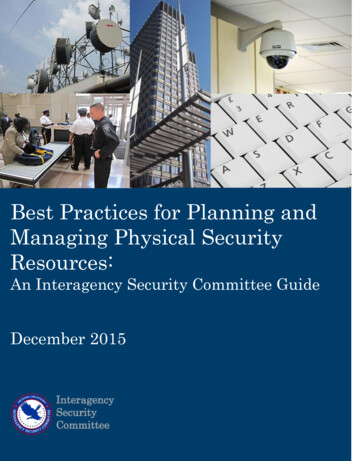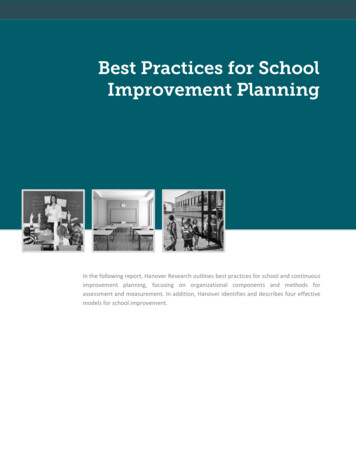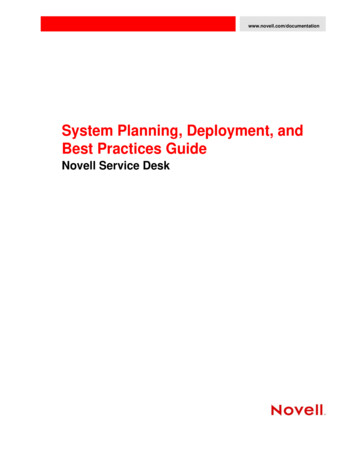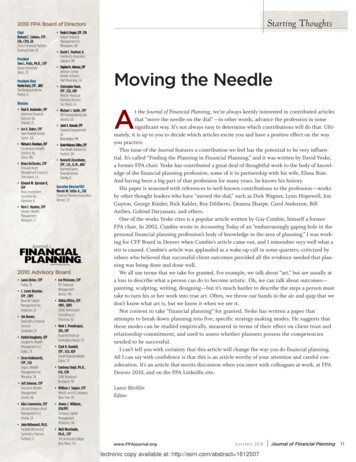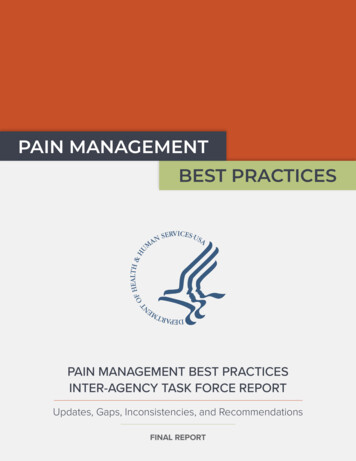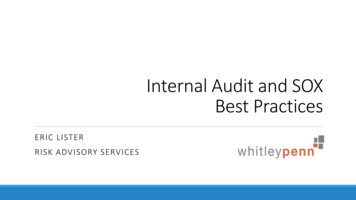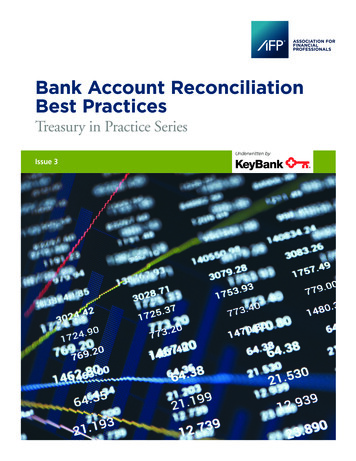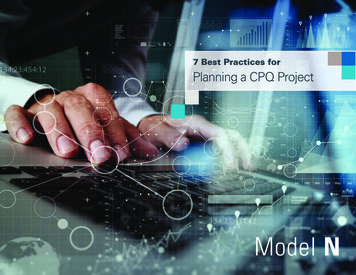
Transcription
7 Best Practices forPlanning a CPQ Project
TABLE OF CONTENTSIntroduction . . . . . . . . . . . . . . . . . . . . . . . . . . . . . . . . . . . . . . . . . . . . . . . . . 3#1 Understand where CPQ will fit and your CPQ process flow . . . . . . . 5#2 Establish a prioritized business requirements list . . . . . . . . . . . . . . . 7#3 Document and fix business process challengesbefore implementation . . . . . . . . . . . . . . . . . . . . . . . . . . . . . . . . . . . . . . . 9#4 Plan for change management and do it yourself . . . . . . . . . . . . . . . 11#5 Ensure knowledgeable CPQ resources are available andengaged in project. . . . . . . . . . . . . . . . . . . . . . . . . . . . . . . . . . . . . . . . . . . 13#6 Determine and plan for required data exchangebetween CRM, CPQ and ERP. . . . . . . . . . . . . . . . . . . . . . . . . . . . . . . . . . . 15#7 Gather together and plan how productinformation will be used. . . . . . . . . . . . . . . . . . . . . . . . . . . . . . . . . . . . . . 172
Introduction3
INTRODUCTIONYou need a CPQ solutionPlanning for CPQ SuccessAccording Gartner Research “What’s Hot in CRMApplications,” Configure Price Quote (CPQ) is one ofthe top two applications that were of interest to theirclients. Once reserved for the manufacturers of themost complex products, many of the growing ranksof CPQ users are not solely adopting CPQ for itstraditional capabilities of delivering error free quotes.CPQ is a powerful driver for growth by enabling directand channels sales to shorten sales cycles, boost salesproductivity and maximize revenues.Companies have implemented Model N CPQ in as little as8-12 weeks using Model N guided implementation packages.The top feedback we received from these companies wasthat they could have done even better if they had plannedmore effectively.A study by AMR Research showed an over 55% increasein cross-sell and up-sell rates by companies employingCPQ solutions. CPQ is also an effective driver fortransformation of sales. An Aberdeen study foundthat organizations using CPQ saw an increase of 45%in responsiveness to customer inquiries and a 28%reduction in sales cycles.4CPQ shortenssales cycles,increases salesproductivity,maximizesrevenuesWe turned to CPQ consulting experts, Novus CPQ, to helpus put together 7 best practices to help companies betterprepare for a CPQ project. Novus CPQ Consulting offersworld-class expertise in CPQ. Their mission is to empowercompanies to make more informed decisions about CPQand to continually improve their CPQ processes. They offerspecialized services for CPQ including: CPQ Process DesignCPQ Configuration OptimizationFunctional IntegrationCPQ Tool SelectionCPQ Project ManagementCPQ Education
#1 Understand whereCPQ will fit and yourCPQ process flow5
#1 UNDERSTAND WHERE CPQ WILL FITAND YOUR CPQ PROCESS FLOWCPQ is an application that fits between the ERP and CRMsystems – increasingly as a native component of theCRM. CPQ plays a lynch pin function in bringing dataand process from these two applications suites togetherto configure, price and quote products, resulting inproposals and ultimately orders back into the ERP.1. Chart out your CPQ solution landscape byunderstanding where the key systems of recordfor pricing and product configuration data willbe maintained.2. Identify critical companion processes such asorder management and understand the points ofintegration to those systems.3. Ensure that you consider your needs for access tosystems of record and companion processes as youselect a CPQ tool. Optimize for solutions that do notforce too much customization or integration effort tofit within your landscape.Salesforcenative CPQstreamlinesthe entireopportunity toorder process4. Ask CPQ suppliers to recommend workflowsthat address your business requirements usingstandard functionality. This is also a good ideaduring CPQ selection.CPQ solutions that provide end-to-end capabilities canstreamline and accelerate the entire opportunity to orderprocess, and some like Model N CPQ, can also automatethe opportunity to contract process. The typical processflow for CPQ looks like RDER/CONTRACTANALYTICS
#2 Establish a prioritizedbusiness requirements list7
#2 ESTABLISH A PRIORITIZED BUSINESS REQUIREMENTS LISTMany times the business requirements list can be anoverwhelming spreadsheet of features. CPQ projectsoften go astray when the emphasis is on fulfilling allthe requirements instead of delivering the high valuebusiness impacts quickly. Likewise, CPQ implementationcosts and effort rise dramatically when the “out ofthe box” capabilities of the CPQ solution need to becustomized. It’s often a good idea to get a feeling forhow different CPQ solutions will address businessrequirements using their standard functionality and flows.Stay withstandardfunctionalityas much aspossible81. Make sure all business requirements aredocumented and prioritized (e.g. critical, high,medium, low) based on the key value drivers forthe CPQ project.2. Review your priorities to make sure they reflectthe “to be” state and are not artifacts of the“as is” state.3. Ensure your CPQ solution’s standard functionalityis well matched to critical requirements, andconsider customization only after completelyunderstanding the tool’s standard capabilities.
#3 Document andfix business processchallenges beforeimplementation9
#3 DOCUMENT AND FIX BUSINESS PROCESSCHALLENGES BEFORE IMPLEMENTATIONOne of the most common benefits of implementinga CPQ solution is to be able to institutionalize thepractices of the A Player in the CPQ process. CPQsolutions can streamline and automate process andfacilitate best practices in a uniform way across theorganization. Many companies also see their CPQsolution as key tool for quickly onboarding newsales people and introducing new products to thesales organization.Institutionalizethe A PlayerProcess101. Look for the best practices process across theorganization – sales, sales ops, finance, productmanagement, product engineering etc. and buildinto the CPQ process.2. Agree on business goals prior to designing theprocess (e.g. reducing documents, shorteningapproval times, centralizing information, etc.)3. Map out the high level process so that you knowwhat you want to do before starting onan implementation.4. Fix any business process challenges beforebeginning an implementation. Make sure tofamiliarize your team with how the CPQ solutionsyou are evaluating or have selected can help fixthe challenges using standard functionality.
#4 Plan for changemanagement anddo it yourself11
#4 PLAN FOR CHANGE MANAGEMENT AND DO IT YOURSELFChange management is often one of the mostunderestimated aspects for CPQ projects. The CPQprocess typically crosses organizational boundariesboth during implementation and once deployed.Ensuring consistent and clear communications beforeand during the process will help engage the companymore effectively in support of the project.Because a CPQ project has many differentstakeholders, it is important to understand thatdifferent stakeholders will need different types ofinformation and varying levels of detail. Resist thetemptation to publish your project managementspreadsheet. Instead, engage the key stakeholdergroups in planning for change management beforethe project to better serve their needs.Differentstakeholdersneeddifferent info121. Keep change management internal. Don’t outsourceto CPQ vendors or SI. Build on close internalrelationships to improve communication.2. Create a single focal point for change managementto provide various stakeholders a “go to” person tohelp them prepare, participate and onboard.3. Plan out key processes with stakeholders as partof the change management. For example, productrollout, order cut over, training, etc.4. Engage with top management consistently with clearinformation that is relevant to them.
#5 EnsureknowledgeableCPQ resourcesare available andengaged in project13
#5 ENSURE KNOWLEDGEABLE CPQ RESOURCESARE AVAILABLE AND ENGAGED IN PROJECTThere are many different methodologies used fordeployment of CPQ solutions: waterfall, agile, hybrid, etc.The selection of a methodology will depend on severalfactors including project goals, internal skill sets, vendorpreferences and SI preferences. There are also severaltools available for project planning and managementas alternatives to creating project plans on your own.However, no tool or methodology is a substitute forthe involvement of knowledgeable people from acrossthe organization.If a CPQ solution and/or SI have not been selected, thenproject management should be considered during theselection process. Discuss with potential tool providersand SI how to best achieve your project goals.141. Identify and recruit A player team membersand agree on decision makers from across theorganization and their backups in case of travel,sickness or vacation.2. Focus the team on the major milestones andactivities and not the low level project details.Communicate condensed versions of projectplan that are digestible – don’t send out yourdetailed plan.3. Create templates for major project artifacts like theRequirements, Functional specification, etc.4. Team with selected CPQ vendor and SI to align onproject methodology.
#6 Determine and plan forrequired data exchangebetween CRM, CPQ and ERP15
#6 DETERMINE AND PLAN FOR REQUIRED DATAEXCHANGE BETWEEN CRM, CPQ AND ERPOne of the top benefits of a CPQ solution is the abilityto put all the relevant data needed for quoting atthe fingertips of sales. Typically, this data resides ina combination of systems, spreadsheets or paperdocuments. In addition, the same information can havedifferent formats. For example, a customer numbermight be 10 digits in one system and 7 in another.For companies with Salesforce CRM, Salesforce nativeCPQ solutions simplify the process by using the samemaster data in the CRM, but there is always external datato consider.1. Determine the data required in the CPQ process andwhere the system of record will be for that data.2. Identify the owners of needed master data and enlisttheir involvement in the project well ahead of time.Salesforcenative CPQleveragesmaster datain CRM3. Survey data and formats to understand the effortrequired to make data accessible and usable for theCPQ tool.Model N CPQ is Salesforce native and has “out of thebox” interoperability with SAP ERP. This greatly facilitatesthe use of master data in both Salesforce and SAPwithout conversion. Also, Model N CPQ is able to directlyuse SAP pricing and product configuration models andrules in SAP Variant Configuration.One of the most complex and costly aspects of CPQimplementations is data integration, with Model N CPQcompanies with Salesforce CRM and SAP ERP will benefitfrom faster, lower cost implementations and muchsmoother workflows.16
#7 Gather togetherand plan howproduct informationwill be used17
#7 GATHER TOGETHER AND PLAN HOWPRODUCT INFORMATION WILL BE USEDAn effective product catalog is a valuable part ofany CPQ solution. The catalog can make the quotingprocess much easier and more effective for sales.The catalog component in a CPQ solution is also away to provide sales with easier access to supportingdocumentation and marketing materials that mayaccompany proposals.The best CPQ solutions also enable guided sellingcapabilities that help sales better meet customerneeds by guiding them to products or solutionsbundles based on information they get fromthe customer.Considersalesenablementlike guidedselling18Product catalogs in enterprise grade CPQ, like Model NCPQ, support product categories and product attributefunctions that help organize products more logically,as well as, simplify maintenance and introduction ofproducts and product options.1. Identify the sources of all product information youwould like to include in the catalog and take stepsto assemble the content prior to embarking on theCPQ project.2. Think about how to organize products to simplifythe process for sales and to support assembly ofsolutions bundles or guided selling if part of yourCPQ plan.3. Decide if you will have supporting documentsor marketing materials and begin the processof assembly. Remember to include documentmaintenance and refresh as a process in yourproject planning.4. Consider enhancing the visual appeal of the productselection process if you feel it might help sales morequickly select the right products.
GET YOUR 7 BEST PRACTICES FORPLANNING A CPQ PROJECT CHECKLISTGet your 7 best practices forplanning a CPQ project checklistNovus CPQ Consulting and Model N have also createda simple tool as a companion for the 7 best practices.In addition, there is a recorded webinar of the 7 bestpractices on the Novus CPQ Consulting web site.Model N CPQ is an enterprise grade, Salesforce nativeCPQ solution that helps companies shorten salescycles, increase sales productivity andmaximize revenues.End-to-end – Model N CPQ streamlines the entirequote to order and quote to contract process,including approvals, resulting in shortened salescycles and more selling time.Robust and Interoperable – Model N CPQ offers builtin synchronization with master data in ERP systems,particularly SAP pricing and variant configurationto reduce implementation effort and cost. And19Model N CPQ was designed for complex configurationchallenges including a patent pending model navigatorthat simplifies configuration for sales people, and a set oftools that simplify building and managing the models andrules that power error free configuration.Performance and Scalability – Model N CPQ has anadvanced Salesforce native performance architecturethat enhanced the Salesforce platform to deliver fasterresponse times for large complex configuration models,and the ability to scale to 1000s of users.For more information about Novus Consulting go towww.novuscpq.com. To learn more about Model N CPQgo to www.modeln.com. To request “The 7 Best PracticesChecklist” send an email to modelncpqforsalesforce@modeln.com.
The catalog component in a CPQ solution is also a way to provide sales with easier access to supporting documentation and marketing materials that may accompany proposals. The best CPQ solutions also enable guided selling cap

